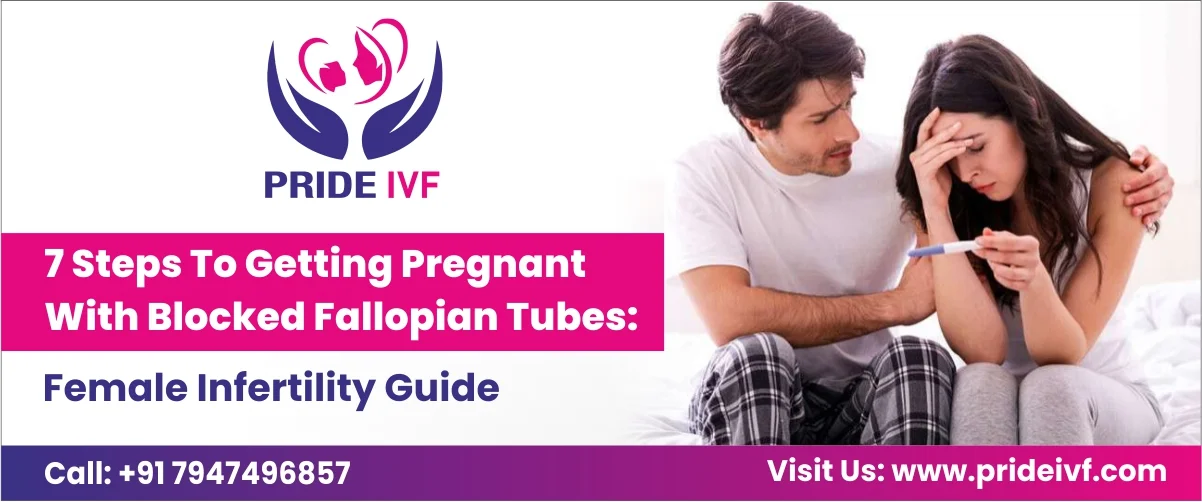Fertility is often a challenging route for many couples who are planning to be parents soon. A very common obstacle that the couples face is infertility due to clogged fallopian tubes as it prevents the normal processes of fertilisation.
Fallopian tubes must be open, have no swelling, and be free from scar tissues. Blocked fallopian tubes are a condition where the tubes that connect ovaries with the uterus are obstructed. The condition prevents the sperm and the egg from meeting. Here are the 7 steps to getting pregnant with blocked fallopian tubes. International Pride IVF Centre in Delhi is staffed by experienced infertility doctors and specialists.




Things to Know About Treating Blocked Fallopian Tubes
Nowadays, most doctors use laparoscopic surgery for blocked fallopian tubes to remove scar tissues from your fallopian tubes. If your fallopian tubes are blocked by large amounts of car tissues, removing blockages isn’t a viable option. Therefore, it is crucial to consult with a specialist to learn the causes of blocked fallopian tubes.
7 Steps to Getting Pregnant with Blocked Fallopian Tubes
Blocked fallopian tubes can be a factor contributing to infertility in women. The fallopian tubes play a crucial role in the reproductive process by providing a pathway for the egg to travel from the ovary to the uterus. If these tubes are blocked, it can prevent the egg from meeting sperm, leading to difficulty in conception. There are multiple blocked fallopian tubes symptoms which one needs to look out for.
Step 1- Seek Professional Guidance
People with fertility issues caused by blocked fallopian tubes should approach specialists. Consult with a reproductive endocrinologist or an expert specialising in fertility to get more insight into your case.
The extent of blocked fallopian tubes can be determined with diagnostic tests like blocked fallopian tubes ultrasound, hysterosalpingography (HSG). The HSG diagnostic test is used to analyse if the uterus or the fallopian tubes are fully or partly blocked. It can also highlight the internal view of the uterus.
Ensure that you are aware of the Hysterosalpingography test price in Delhi before going for a diagnosis. It is an X-ray procedure used to view the insides of the fallopian tubes.
Step 2- Role of the Tubal Ligation Reversal Surgery
Tubal ligation reversal surgery is an effective option for some couples. The method of restoration of the fallopian tubes and their function is called tubal ligation reversal. It involves joining the tubes in order to make them functional again.
This surgery may not be convenient for all couples, especially in situations where there is massive damage. Nevertheless, it may assist some women in attaining natural conception. Discuss with your fertility specialist whether it’s possible to reverse your tubal blockage.
Step 3- Explore Fertility Treatments like IVF
After the assessment of the amount of the blockage, your fertility specialist may suggest a number of ARTs. ART, also known as Assisted Reproductive Technology, is meant to boost your chances of getting pregnant with blocked fallopian tubes.
Blocked fallopian tubes are a common problem among some infertile couples. One of the most common and successful blocked fallopian tube treatments for this problem is InVitro fertilisation (IVF). It is considered an advanced and highly effective assisted reproductive technology. It makes conception possible even with blocked fallopian tubes.
This procedure involves removing eggs from the woman’s ovaries, followed by fertilising the eggs in a laboratory. These embryos are then scrutinised for their quality and the developmental process. When they are ready, a few viable embryos are selected and introduced into the woman’s uterus for the continuation of pregnancy.
IVF treatment in Delhi has an unblemished track record of helping women conceive with blocked fallopian tubes. This technique has been beneficial in women who have unilateral tubal blockage or broad damage to fallopian tubes. IVF provides a controlled setting for fertilisation and embryo growth during the first few days, thereby enhancing the probability of a successful pregnancy with blocked fallopian tubes.
In addition to dealing with tubal obstruction, this method offers a flexible approach to infertility treatment. Moreover, it can be adapted to the specific circumstances of every couple. Infertility problems involving the fallopian tubes continue to haunt some couples. But IVF is still a breakthrough that gives hope to such couples to parenthood.
Lets get started
Step 4- Change Your Lifestyle
Female infertility can be corrected by having better health and lifestyle adjustments. Couples should maintain a good weight, consume a balanced diet, and do regular exercises each day. Likewise, quitting smoking and limiting alcohol intake could also constitute positive lifestyle changes that may enhance fertility.
Sufficient sleep as well as managing stress are also vital as stress can be damaging to reproductive health. Such lifestyle changes are known to enhance the chances of conception in situations where fallopian tubes are clogged.
Step 5- Monitor Your Fertility and Ovulation Cycles
Tracking menstrual and ovulation cycles can help you conceive with blocked fallopian tubes. You can track ovulation with tools like ovulation prediction kits, cervical mucus monitoring, etc. It is important to track fertility for optimal chances of conception.
Tracking fertility also allows you to time intercourse for the best results. You should look at your vaginal mucus each day and record the results on a chart. If the mucous is heavy and wet, you are ovulating.
Also Read: How To Open Blocked Fallopian Tubes?
Step 6- Address the Underlying Health Conditions
Blocked fallopian tubes and fertility problems may arise from some preexisting health conditions. PCOS or endometriosis for instance are conditions that affect fertility and require specific treatment.
You must maintain close contact with your doctor in order to diagnose and treat medical conditions that prevent you from getting pregnant with blocked fallopian tubes. Addressing these issues will enable you to attain better reproductive health and successful pregnancy.
Step 7- Get Emotional Support and Counselling
Couples experience emotional strain when handling issues related to fertility, mainly if it is due to blockage of fallopian tubes. It is important to seek emotional support and counselling while conceiving.
Couples can benefit from professional counselling as it offers coping strategies, improved communication and a supportive space. It will help couples manage stress factors associated with infertility. Joining support groups or connecting with others who have undergone similar challenges can offer a sense of community and understanding.
Complications Associated with Blocked Fallopian Tubes
Ectopic pregnancy is the most common complication of blocked fallopian tubes. If there is a blockage in the fallopian tube, the egg may get fertilised. However, there are chances of the egg being stuck. It can result in an ectopic pregnancy in women with blocked fallopian tubes.
Surgery associated with the removal of the tubes also increases the risks of developing ectopic pregnancy. Doctors suggest IVF instead of surgery because of these risks. IVF has emerged as the top female infertility treatment in the last few years.
Blocked fallopian tubes pose a significant fertility issue but there are several measures couples could use to boost natural conception. Consequently, there are several strategies that can be followed in order to enhance one’s fertility.
For instance, people can seek advice from professionals, explore fertility treatments and make some vital lifestyle alterations. While every couple’s journey is different, working closely with healthcare professionals can help develop a plan that’s specific to your needs.
If you have been diagnosed with blocked fallopian tubes, consult with the International Pride IVF Centre. It is one of the best IVF centresi with a track record of helping couples to conceive through IVF. It offers comprehensive fertility care with a patient-centred approach.




